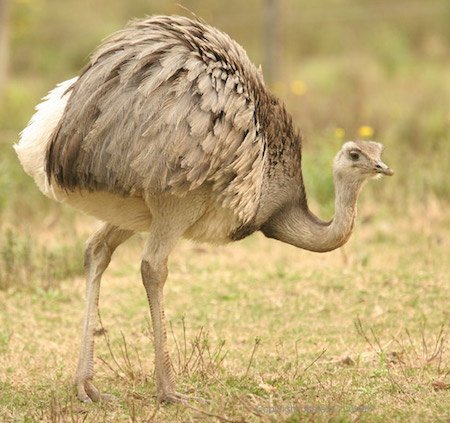Rheidae – Rheas

The Rheas are large (the Greater Rhea is the largest bird in South America weighing c. 25kg and standing up to 1.8m tall) flightless birds that are three toed, terrestrial and have long legs and long necks. They live for about 10 years in the wild. The are confined to South America where they inhabit open grassland, grassy wetlands or scrub ranging from sea-level up to 4500m and even into very arid areas. When not breeding they form flocks of up to 100 birds. They generally eat broadleaf foliage, seeds and fruit but will also take insects, scorpions, reptiles, and small mammals and birds. Often eating seeds and tough vegetation they swallow pebbles which help grind the food and so aid digestion. As they tend not to eat grains they are considered beneficial to farmers as they will take pests from crops including locust, beetles and other pests.
Like other ratites males tend eggs and nests.
The IOC recognises just two species in this family, which are:
Greater Rhea Rhea americana
Lesser Rhea Rhea pennata
The ‘Puna Rhea’ was formerly considered a separate species but recent evidence shows it to be a race of Lesser Rhea.
-
Greater Rhea Rhea americana
Species AccountImage of skull & Morphology -
Greater Rhea Rhea americana
IUCN Species StatusIUCN species profile... -
Greater Rhea Rhea americana
Species AccountSound archive and distribution map -
Greater Rhea Rhea americana
Species Account -
Greater Rhea Rhea americana
Cornell Species AccountCornell species account and image... -
Lesser Rhea Rhea pennata
IUCN Species StatusIUCN species profile... -
Lesser Rhea Rhea pennata
Species AccountSound archive and distribution map -
Lesser Rhea Rhea pennata
Species Account -
Lesser Rhea Rhea pennata
Cornell Species AccountCornell species account with image...
-
Number of bird species: 2
Both species have a number of races.The Lesser Rhea races are:
P.p. garleppi Chubb 1913 found in southern Peru, southqwest Bolicia and northwest Argentina
P.p. tarapacensis Chubb 1913 found in northern Chile
P.p. pennata d'Orbigny 1834 found in southern Chile and western central and southern Argentina.The Greater Rhea races are:
R.a. americana Linneus 1758 found from northeat to southeast Brazil
R.a. intermedia Rothschild & Chubb 1914 found in southeat Brazil and Uruguat
R.a. nobilis Brodkorb 1939 found in eastern paraguay.
-
Lesser Rhea Rhea pennata
ArticleEnvironmental factors influencing the distribution of the Lesser Rhea (Rhea pennata pennata) in southern Patagonia -
Mating Behavior of the Male Greater Rhea
ArticleThaïs L. Codenotti and Fernando Alvarez - The Wilson Bulletin, Vol. 113, No. 1 (Mar., 2001), pp. 85-89 -
Stress in wild Greater Rhea populations Rhea americana
Article...effects of agricultural activities on seasonal excreted glucocorticoid metabolite levels. A. Lèche, G. Bazzano, C. Hansen, J. L. Navarro, R. H. Marin, M. B. Martella - Journal of Ornithology, October 2014, Volume 155, Issue 4, pp 919-926
-
Greater Rhea Rhea americana
VideoZoo images... The Greater Rhea (Rhea americana) is a flightless bird found in eastern South America. Other names for the Greater Rhea include the Grey, Common, American Rhea, ñandú (Guaraní) or ema (Portuguese). One of two species in the genus Rhea, in the family Rheidae, the Greater Rhea is endemic to Argentina, Bolivia... -
Lesser Rhea Rhea pennata
VideoLesser Rhea (Rhea pennata), is a large flightless bird, but the smaller of the two extant species of rheas. It is found in the Altiplano and Patagonia in South America...
